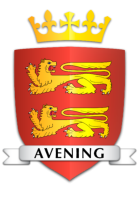

© Avening Parish Council 2023
“Preserve, Conserve, Enhance”
12 George Newman
Private: Royal Army Medical Corps Attached to 108th Heavy Battery Unit, RGA The National Archives Records show George named as Horace Jesse George Newman, indeed, he was baptised as such in Holy Cross Church on Sunday the 29th of November 1892. The Parish Register quotes his birth date as Thursday the 29th of September, some eight weeks earlier. However, he always referred to himself as George and the Army recognised him as such. He was the eldest son of eight children (he had five brothers and two sisters), born to George William Newman (1865-1905) and Cecilia Ann née Fletcher (1872-1924). George's Newman grandfather was born in Cherington in 1832, his father being Richard Newman, born Southrop around 1793. George's mother Cecilia was of solid Avening stock. Her father John Fletcher (1835- 1909) married Ann Ind on the 27th of August 1857 at Holy Cross Church. Both maternal ancestors can be traced back a further four generations in Avening. All of George's male ancestors appear to have been agricultural labourers. In the 1901 census George, aged 8, is listed with his family living on Old Hill. Unfortunately, there are no records available on George's military service except that we must assume that he was in the Royal Army Medical Corps prior to the outbreak of war as the Medal Rolls tell us that he embarked for France on the 18th of August 1914, only 14 days after war was declared. As a member of the RAMC he could have been serving in a hospital at home or overseas, as a stretcher-bearer anywhere on the front or, as is likely in his case, on attachment to a fighting unit to supply immediate medical assistance when needed. We know that in February 1916 he was attached to the 108th Heavy Battery Unit of the Royal Garrison Artillery, serving in the Ypres area. The role of the 108th was shelling enemy positions, particularly their artillery sites and heavy gun battles developed frequently. Although set back from our own front line, this did not make them immune from attack. We do not know exactly what happened on the fateful day of Sunday the 20th of February 1916 but George was killed along with three others on the 108th Battery. All four men were buried side by side in Railway Chateau Cemetery a few kilometres from Ypres town centre. The Commonwealth War Graves Commission tend the cemetery and their website has a photograph on which can be clearly seen the four graves. George received, posthumously, the Victory Medal, the British Medal and the 1914 Star. He was 23 years old when he died and was unmarried. I thank his niece, Peggy Chappell of Woodstock for her assistance and for the photograph of George in his army uniform.
AveningArchive
WW1 Heroes





© Avening Parish Council 2023
AveningArchive
12 George Newman
Private: Royal Army Medical Corps Attached to 108th Heavy Battery Unit, RGA The National Archives Records show George named as Horace Jesse George Newman, indeed, he was baptised as such in Holy Cross Church on Sunday the 29th of November 1892. The Parish Register quotes his birth date as Thursday the 29th of September, some eight weeks earlier. However, he always referred to himself as George and the Army recognised him as such. He was the eldest son of eight children (he had five brothers and two sisters), born to George William Newman (1865-1905) and Cecilia Ann née Fletcher (1872-1924). George's Newman grandfather was born in Cherington in 1832, his father being Richard Newman, born Southrop around 1793. George's mother Cecilia was of solid Avening stock. Her father John Fletcher (1835-1909) married Ann Ind on the 27th of August 1857 at Holy Cross Church. Both maternal ancestors can be traced back a further four generations in Avening. All of George's male ancestors appear to have been agricultural labourers. In the 1901 census George, aged 8, is listed with his family living on Old Hill. Unfortunately, there are no records available on George's military service except that we must assume that he was in the Royal Army Medical Corps prior to the outbreak of war as the Medal Rolls tell us that he embarked for France on the 18th of August 1914, only 14 days after war was declared. As a member of the RAMC he could have been serving in a hospital at home or overseas, as a stretcher- bearer anywhere on the front or, as is likely in his case, on attachment to a fighting unit to supply immediate medical assistance when needed. We know that in February 1916 he was attached to the 108th Heavy Battery Unit of the Royal Garrison Artillery, serving in the Ypres area. The role of the 108th was shelling enemy positions, particularly their artillery sites and heavy gun battles developed frequently. Although set back from our own front line, this did not make them immune from attack. We do not know exactly what happened on the fateful day of Sunday the 20th of February 1916 but George was killed along with three others on the 108th Battery. All four men were buried side by side in Railway Chateau Cemetery a few kilometres from Ypres town centre. The Commonwealth War Graves Commission tend the cemetery and their website has a photograph on which can be clearly seen the four graves. George received, posthumously, the Victory Medal, the British Medal and the 1914 Star. He was 23 years old when he died and was unmarried. I thank his niece, Peggy Chappell of Woodstock for her assistance and for the photograph of George in his army uniform.WW1 Heroes



























